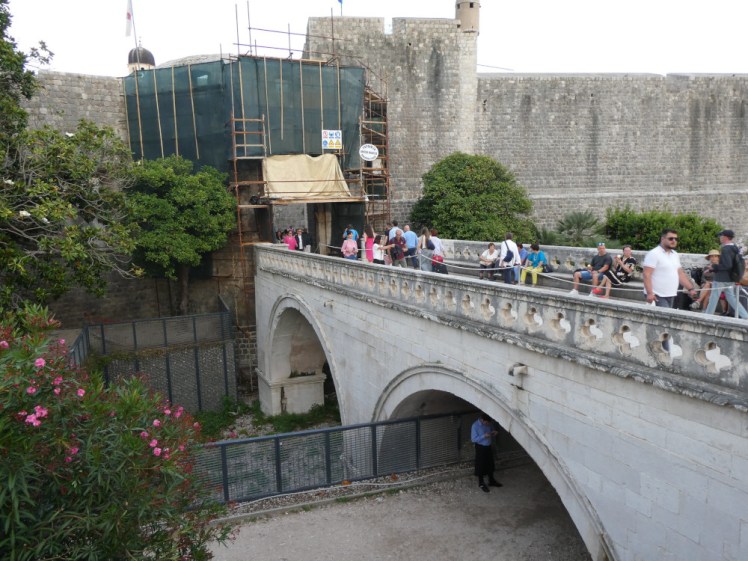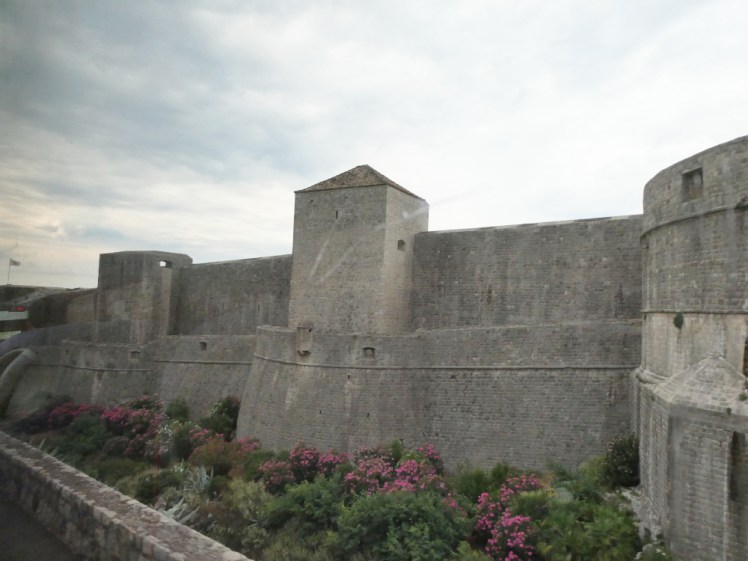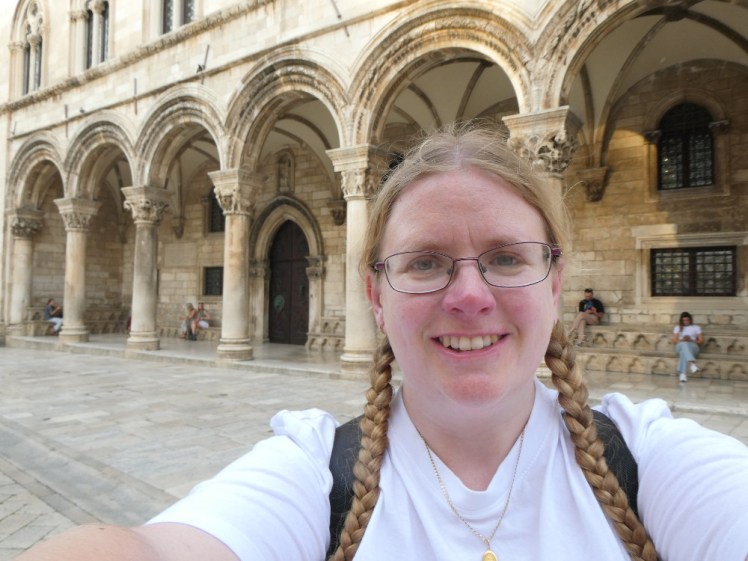If you’re going to go to Dubrovnik, you’re going to go and explore the Old Town. For me, it was more out of a “this is the done thing” than out of any real desperate desire. I was in Croatia for the joy of being in Croatia and for the sea kayaking which I would have done and loved wherever along Croatia’s long coast I had ended up. I hadn’t ended up in Dubrovnik specifically for any other reason than that it was where I could get a cheap easyJet flight from Bristol – I could just as easily have found myself in Zadar or Split or Pula. But it was Dubrovnik.

I gather that part of the reason Dubrovnik gets the lion’s share of Croatia’s tourism is that it was used for filming for Star Wars and in particular for Game of Thrones – every other shop in the Old Town is an “authorised retailer” of Game of Thrones merchandise. But I’ve never watched Game of Thrones. I’ve read the books, some years ago now, and never felt any desperate desire to re-read, so I know what King’s Landing is but I don’t really picture Dubrovnik on those rare-to-non-existent times it crosses my mind.
I was staying in Gruž Port (easy access to the sea kayaking I had planned!), three or so kilometres north of the Old Town. That sounds like an easy enough walk but what I discovered on the airport shuttle bus on my first night was that it’s uphill in both directions. Luckily there are plenty of buses running pretty much from the bottom of the steps down from my apartment to the port, it costs €2 each way if you haven’t sorted out any kind of local transport pass and it only takes about 15 minutes – and the buses are air-conditioned! The buses run to Pile Gate, which is the main entrance to the Old Town and it’s packed. It’s not just local buses, it’s giant tour buses, shuttle buses from the cruise ships, it’s people arriving on foot, it’s people trying to find the nearest car park and it’s hot. It’s hot inside the walls of the Old Town but the streets are generally narrower and less open and an absolute labyrinth of tall buildings so there’s a lot more shade and it keeps the temperature down a little bit.

So, there are two things you spot as soon as you walk in through the main gate. First is the walking tour of the city walls. Well, not so much “tour” as “give us some money and you can go up and explore by yourself”. I’d heard that you have to pay to go up the city walls but I hadn’t really realised that there is only one place to get up there and it’s entirely controlled. Spoiler: I didn’t do it. It was hot, I was tired, I did a lot of walking just exploring at floor levels and I didn’t fancy queuing and fighting through crowds to get up on walls where there’s no shade or shelter. As for alternative ways to get up, well, those walls have withstood centuries of attacks, including the Siege of Dubrovnik during the breaking up of Yugoslavia in the 90s, so there was no way little old me was going to mount an assault on them anywhere except the official entrance. They’re quite incredible walls, probably best viewed from the outside if you want to get a sense of the scale of them. Once you’re inside, the city itself pretty much blocks out the view of them but from the airport bus, for example, you really see how huge they are – how high, how solid and you really start to realise how these things have withstood attempts to break into the city-state over the centuries.

The second thing is Onofrio’s Large Fountain, which is a huge slab of carved stone like a vastly overgrown wedding cake with water spouting from the sides. Nowadays you can drink from it or splash cold water on your face to cool down but it was built originally for travellers to wash in. I encountered this in Tbilisi as well, except their water is hot, the idea of washing before entering the city walls as a way to prevent outbreaks of various plagues. There’s a long straight wide street stretching east to west from here to the old port, the Stradun. At the far end is Onofrio’s Small Fountain, a much more traditional small decorative fountain.

In this square at the eastern end of Stradun is a church. It’s easy to assume this is Dubrovnik’s cathedral, especially since there are tourists flooding into it. A word of warning, they’ll take a peek at what you’re wearing before they let you in, so be prepared with a scarf or pashmina if you’re wearing short shorts or a skirt or have your shoulders visible. It’s a nice enough church if you like Baroque but this is actually St Blaise’s Church. St Blaise was an Armenian martyr who somehow got himself adopted as Croatia’s local saint. The actual cathedral is the more barn-like building behind. I didn’t realise that until too late in the day to go inside.

Now you can go out through the gate, round the edge of the old harbour and follow the walls along the gorgeous turquoise coast, past the huge St John’s Fortress, which is apparently home to a pretty impressive aquarium. Outside, however, is a public swimming area. It’s all a bit concretey and a bit rocky but there are steps down into the water and a roped-off area to keep the various boats and pleasure craft away from swimmers. I sat on the edge and dangled my feet but I couldn’t quite figure out how to get changed right out in public for a swim.

If you go back into the city via the gate on the southern end of the old port, you’ll walk straight into the cathedral and to your right is an interesting building, built partly in the Gothic style but partly in the Renaissance style, which means that it’s taken some Romanesque design elements, mainly the gorgeous decorative rounded arches, so like the Norman style. I love a mix of Gothic and Norman so I was immediately drawn to this building. This is the Rector’s Palace, the Rector of Dubrovnik, or formerly Ragusa, being the most powerful man in government between about the 14th and 19th centuries. Interestingly, the Rector was elected for just one month, during which he was pretty much confined to the palace and he was then ineligible for the role again for two years. Must be very odd to swap your leader twelve times a year. Another feature that I loved in the Rector’s Palace is the windows. They’re made up of circles. I thought this was just really old glass that had been spun out into a rondello, just like you see in old pubs. But I gather that was how you made largeish windows cheaply and this place certainly wasn’t built cheaply, so this was a deliberate design decision. I did a little reading and it seems this is actually something called crown glass. Whatever it is, however it came into being, I really liked it.


After that, I took to the back streets. While Dubrovnik is incredibly touristy, they do seem to stick to the main routes and once you get a street or two away, it suddenly goes very quiet, not to mention very steep, very narrow and very well-shaded. Around Stradun, Dubrovnik feels a bit like a theme park. It’s all too shiny, too well-preserved, too pristine, too many souvenir shops and Game of Thrones shops and cafes. This isn’t a place where Croatian people actually live. This is a place where the locals have been elbowed out to make space for the tourists. But a few streets away, especially around the southern end of the Old Town, that’s where you suddenly find the houses and apartments of real people, of washing hung in courtyards and over narrow staircases. Of course, a lot of them are now rental apartments and accommodation for tourists – I bet you could get away with charging a lot for staying right here in the Old Town, enough to pay off the mortgage and buy a place outside the walls to actually live in. But it feels like real Dubrovnik, genuine old Dubrovnik, the one before the tourist invasion, the real thing.

I think I’d like to see Dubrovnik in the winter. Maybe it’s not the season for sea kayaking but I suspect it would be quieter in the Old Town and I suspect I’d sweat through fewer clothes – although I have to say, I didn’t feel the heat nearly as much as I have in my previous trips to the Mediterranean, to Malta and Cyprus. I liked Dubrovnik well enough but I think what I liked was the beautiful blue water and spending time just enjoying the break rather than ticking off the “three thousand things to see in Dubrovnik” list. However, I did get an interesting and unique perspective on the city… but that’s a story for next time, so come back on Thursday to hear it.
